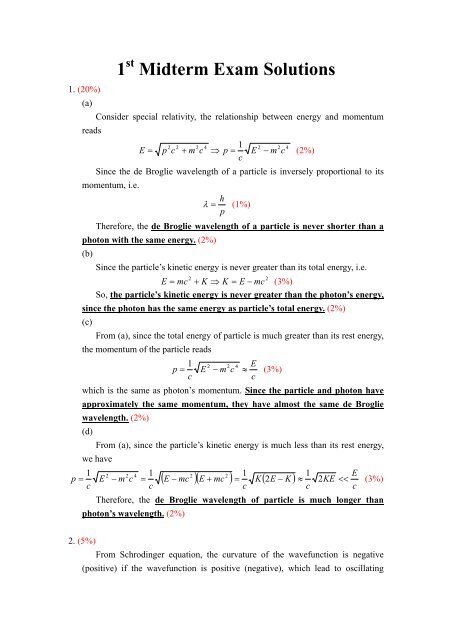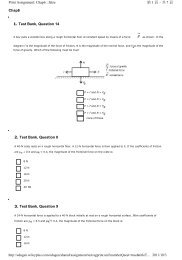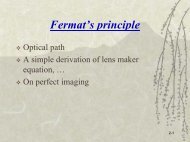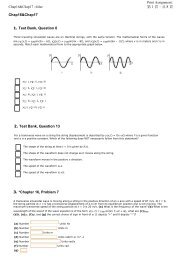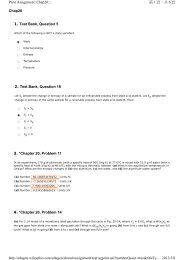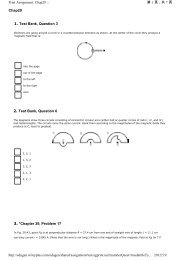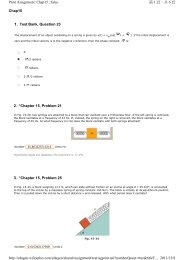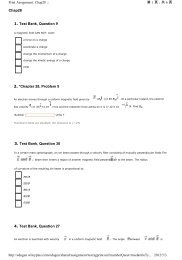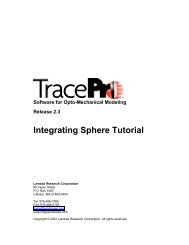1st Midterm Exam Solutions
1st Midterm Exam Solutions
1st Midterm Exam Solutions
Create successful ePaper yourself
Turn your PDF publications into a flip-book with our unique Google optimized e-Paper software.
1 st <strong>Midterm</strong> <strong>Exam</strong> <strong>Solutions</strong><br />
1. (20%)<br />
(a)<br />
Consider special relativity, the relationship between energy and momentum<br />
reads<br />
E<br />
E m c<br />
c<br />
Since the de Broglie wavelength of a particle is inversely proportional to its<br />
momentum, i.e.<br />
h<br />
(1%)<br />
p<br />
Therefore, the de Broglie wavelength of a particle is never shorter than a<br />
photon with the same energy. (2%)<br />
(b)<br />
Since the particle’s kinetic energy is never greater than its total energy, i.e.<br />
2<br />
2<br />
E mc K K E mc (3%)<br />
So, the particle’s kinetic energy is never greater than the photon’s energy,<br />
since the photon has the same energy as particle’s total energy. (2%)<br />
(c)<br />
From (a), since the total energy of particle is much greater than its rest energy,<br />
the momentum of the particle reads<br />
1 2 2 4 E<br />
p E m c (3%)<br />
c<br />
c<br />
which is the same as photon’s momentum. Since the particle and photon have<br />
approximately the same momentum, they have almost the same de Broglie<br />
wavelength. (2%)<br />
(d)<br />
From (a), since the particle’s kinetic energy is much less than its rest energy,<br />
we have<br />
1 2 2 4 1<br />
2<br />
2 1<br />
1 E<br />
p E m c E<br />
mc E<br />
mc K2E<br />
K 2KE<br />
(3%)<br />
c<br />
c<br />
c<br />
c c<br />
Therefore, the de Broglie wavelength of particle is much longer than<br />
photon’s wavelength. (2%)<br />
2 2 2 4 1 2 2 4<br />
p c m c p (2%)<br />
2. (5%)<br />
From Schrodinger equation, the curvature of the wavefunction is negative<br />
(positive) if the wavefunction is positive (negative), which lead to oscillating
ehavior.<br />
3. (25%)<br />
(a)<br />
2<br />
p<br />
The Hamiltonian for a free particle is Hˆ<br />
. Its eigen-value corresponds to<br />
2ˆ<br />
m<br />
the total energy of the particle. Therefore, its eigen-value is allowed to be any<br />
positive real number. (5%)<br />
(b)<br />
For a free particle, satisfies the Schrodinger equation<br />
2 2<br />
d<br />
i x, t<br />
x,<br />
t<br />
2<br />
t<br />
2m<br />
dx<br />
Apply the separation of variables and let the eigen-value be E , we have the<br />
following solution for Schrodinger equation<br />
x, t exp i t<br />
k x (3%)<br />
<br />
E 2mE<br />
Where , k . (2%)<br />
<br />
(c)<br />
The most general form of wavefunction for free particle is the superposition of<br />
all possible modes which reads<br />
Ak<br />
<br />
<br />
x<br />
t<br />
dkAk<br />
exp<br />
it<br />
k x<br />
<br />
, (5%)<br />
Where is arbitrary function satisfies normalization condition.<br />
(d)<br />
Phase velocity describes the propagating velocity of phase, which means if an<br />
observer travels with the phase velocity of a travelling wave, the observed phase<br />
keep unchanged. It is not the actual propagating velocity of wave when the<br />
dispersion relation is not linear. For matter waves, since the dispersion relation is<br />
quadratic, its phase velocity reads<br />
E p v<br />
v p<br />
(5%)<br />
k p 2m<br />
2<br />
Which is obviously not the propagating velocity of matter wave.<br />
(e)<br />
The group velocity of matter wave is<br />
v g<br />
2<br />
p p<br />
k<br />
<br />
E v<br />
k p p<br />
<br />
m<br />
(3%)<br />
2 m<br />
Which is the actual propagating velocity of matter wave. This is only valid
for wave-packet, which means the wave-vector must be localized in k -space<br />
as well as its position in real space. (2%)<br />
4. (35%)<br />
(a)<br />
The energy eigen-value of given eigen-states are<br />
2 2<br />
2 2 2<br />
2 2 2<br />
d n <br />
n <br />
En<br />
n<br />
<br />
E<br />
2 n<br />
<br />
2 n<br />
<br />
n<br />
(5%)<br />
2<br />
2m<br />
dx 2ma<br />
2ma<br />
(b)<br />
The Heisenberg uncertainty principle tells<br />
<br />
x p<br />
(2%)<br />
2<br />
We may simply estimate x and p by<br />
<br />
x a , p<br />
2 mEg<br />
(1% each)<br />
a<br />
<br />
x p<br />
(1%)<br />
2<br />
Which satisfies Heisenberg uncertainty principle.<br />
(c)<br />
From (a), if the size of box is halved, the eigen-energies become four times<br />
of original. Similarly, they become one fourth of original eigen-energy if the<br />
size of box is doubled. (5%)<br />
(d)(5%)<br />
From Fourier transformation (uncertainty principle), the larger spread in<br />
position space lead to smaller spread in momentum space, and vice versa<br />
(e)<br />
(f)<br />
(g)<br />
1<br />
<br />
5<br />
i 2 3 x<br />
4 i<br />
2x<br />
<br />
3<br />
4e<br />
<br />
sin e sin <br />
<br />
1 2<br />
(5%)<br />
a 5 a 5 a<br />
(The phase factor can be ignored here.)<br />
2<br />
2 2<br />
2 2<br />
p a<br />
*<br />
d 9 16 73 <br />
E dx<br />
E1<br />
E2<br />
0<br />
2<br />
2m<br />
<br />
<br />
2m<br />
dx<br />
<br />
(5%)<br />
25 25 50 ma<br />
W E1<br />
2<br />
hen we measure the energy of the system, only and E are possible to<br />
be obtained for the given state. If we do the same measurement on the same<br />
system with the same given state many times, the average value of the result<br />
is given by (f), although all these measurement only give E<br />
1<br />
and E 2<br />
each
time. (5%)<br />
5. (15%)<br />
(a) (5%)<br />
The top figure has highest oscillation frequency,<br />
which means it has highest kinetic energy. Therefore,<br />
it corresponds to E<br />
A<br />
. The bottom figure shows that<br />
the total energy is lower than V 0<br />
. The exponential<br />
decay of probability density at right hand side of<br />
bottom figure is because of tunneling effect. Then, we<br />
may deduce that the bottom figure corresponds to E<br />
C<br />
.<br />
The middle figure shows that its total energy is higher<br />
than V<br />
0<br />
, but lower than top figure, so it corresponds to<br />
E<br />
B<br />
.<br />
(b) (5%)<br />
For the case that the particle has total energy higher<br />
than the potential energy at region 0<br />
, a<br />
as shown in<br />
top and middle figure, the particle has higher kinetic<br />
energy in region <br />
a,0<br />
. Which means it passes<br />
through this region requires less time so that it is harder<br />
to be found in this region. For the bottom figure, since<br />
the particle’s total energy is not enough to encounter the<br />
potential barrier in region 0 , a, it can only move back and forth in region<br />
<br />
a,0. However, it is still possible to find the particle in region 0,<br />
a<br />
because<br />
of tunneling effect.<br />
(c) (5%)<br />
E<br />
C<br />
is not the ground state because its probability density has several nodes.<br />
The probability density of ground state is expected as shown in the following<br />
figure. Single peak appears in left hand side, with very small magnitude of<br />
“leaking” to right hand side which is caused by tunneling effect.


